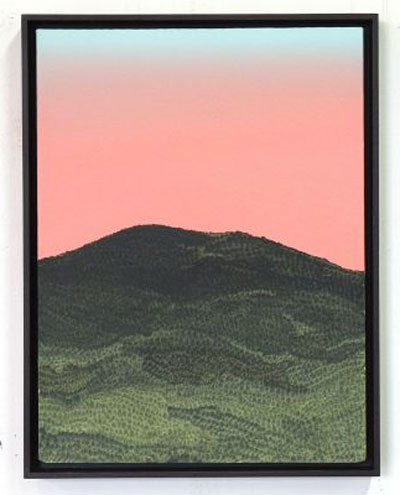
March 5, 2014

Dark, hazy landmasses are rendered in Jake Longstreth’s “Particulate Matter” series on display at the Ever Gold Gallery. Photo: Courtesy Of The Artist
Jake Longstreth, Sean McFarland show at Ever Gold Gallery
Kimberly Chun
Nature - as seen through the strange, rough magic of memory - has been the overriding force behind Los Angeles painter Jake Longstreth’s latest paintings, his “Particulate Matter” series. Dark or hazy landmasses are rendered with what he describes as “thin, nervous-looking strokes, done in an off-the-cuff manner,” in contrast with tonal skies and the occasional rambunctious pink or green cloud. Some of the works from the series will appear in his latest exhibit, a collaborative show at Ever Gold with longtime friend Sean McFarland, a former California College of the Arts master’s of fine arts classmate, fellow outdoors aficionado and photographer. We spoke with Longstreth, 37, by phone from Los Angeles.
Q: Why did you decide to do an exhibit with Sean McFarland?
A: We’ve known each for a long time, and we’ve always just been temperamentally landscape artists. While he was down here in the last year, we were hanging out and decided, let’s do a show. Our work converged at a similar point.
Q: Why did you make the move from painting architecture to these more natural landscapes?
A: It wasn’t an overnight decision. I was interested in the sort of creeping corporatism and homogenization that anyone can easily observe, the day-to-day ubiquity of Best Buy and Walmart. I thought that’s an interesting, hugely influential and weirdly overlooked aspect of our culture, and that’s right there in the landscape.
I did that for a while, and my work just started shifting in more ambiguous and atmospheric ways, and I just became obsessed. Sometimes you’ve got to go the opposite way as an artist. It took a while to figure out: The old architectural paintings were done in acrylic and based on photographs, and the “Particulate Matter” series are oil and studio paintings done from a lifetime of observation and memory.
Q: So your landscapes aren’t based on any real places?
A: They’re not based on photographs. They’re sort of palette- and tone-driven, though the topography and palette are certainly informed by Southern California, where I live. But they’re not literal depictions of specific pieces of land. When I’ve done that in the past, the paintings lack idiosyncratic qualities - they’re dime-a-dozen landscape paintings. I find that working in the studio and not being super beholden to specific topography but definitely drawing on pretty vivid sense memory, they’re more interesting. The better of the paintings strike a nice balance between a specific sense of place and a broader metaphorical reading because, you know, that’s what landscape art is about.
Q: The series’ name seems to allude to environmental decay?
A: It’s implied, but certainly not intended as didactic political-message art - that seems like a fairly hopeless cause.